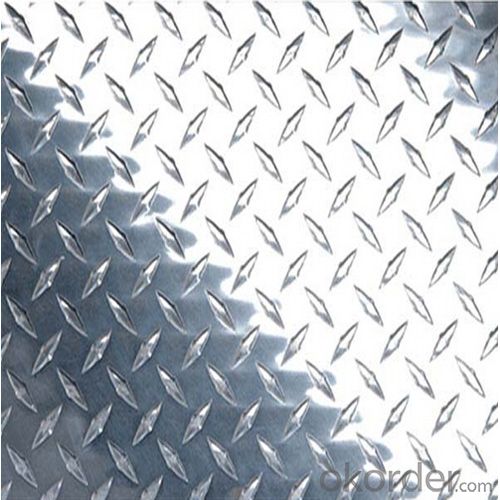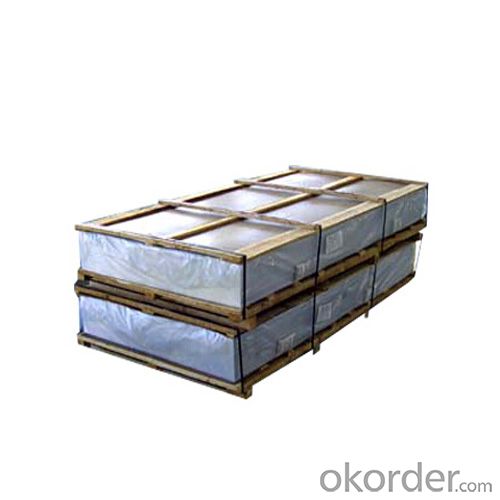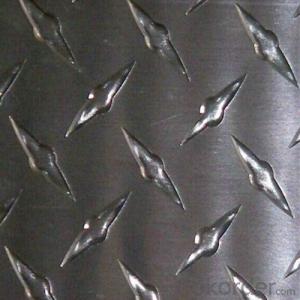Embossed Aluminium Plate for Package with High Quality
- Loading Port:
- Shanghai
- Payment Terms:
- TT OR LC
- Min Order Qty:
- 5 m.t.
- Supply Capability:
- 10000 m.t./month
OKorder Service Pledge
OKorder Financial Service
You Might Also Like
Item specifice
1.Structure of Embossed Aluminium Plate for Package Description:
1050 1060 1070 1100 1235representative series aluminum plate is also known as pure aluminum, in the series in 1xxx series belongs to all the alumina quantity of a maximum number of series. Purity can achieve 99.00% above. 3xxx series aluminum represents 3003 3004,3005, 3 A21 primarily. And can be called in the 3xxx series aluminum antirust aluminum production process more outstanding. The 3xxx series aluminum plate is by manganese as the main component. Content at 1.0-1.5 between. Is a rust-proof function better series. Conventional application in the air conditioning, the refrigerator, such as car in damp environment
2.Main Features of Embossed Aluminium Plate for Package :
Low density, light in weight
Anti-corrosion
Strong
Malleable
Naturally good looking
Recyclable
3.Embossed Aluminium Plate for Package Images:



4. Embossed Aluminium Plate for Package Specification:
| Grade | Temper | Plate Thickness (mm) | Bar Thickness (mm) | Width (mm) | Length (mm) | Surface |
| 1050 1060 1100 3003 3004 3105 5052 5005 5754 5083 6061 6063 | 0,H12, H14,H16 H18,H24H24,H26 H32,H34 | 0.8-12 | 0.1~5 | 10~1200 | 1000-10000 | PE / PVDF |
5.FAQ
Q1.How long have you been in this product?
A1:More than 10 years.
Q2. What's the minium quantity(MOQ)?
A2. 5 Metric tons
Q3. How long is shipping time?
A3. 7 (ready-made products)-25 days(OEM)
Q4. How do you guarantee the quality?
A4. 1. Cooperating and Exchaning experience with sevral quoted aluminum companies
2. Japanese and Swiss production line and skilled works (regular training and testing)
3. more than 10 years production experience.
Q5. Do you have after sale service?
A5. Yes. Any quality problem occurs within one year, pls take photoes,we will be responsible.
- Q:What are the different alloy compositions available for aluminum sheets?
- There are various alloy compositions available for aluminum sheets, including 1xxx, 3xxx, 5xxx, and 6xxx series. Each series has unique properties and characteristics, making them suitable for different applications.
- Q:is putting Aluminium foil behind the wind shield actually generate more heat and make the car hotter inside or make the car inside cooler? assume you put foil behind all windows.
- Aluminum foil absorbs heat because the foil, like anything else, will absorb energy from a heat source according to thermodynamic principles. What that translates into is this: heat goes from where it is to where it isn't, or heat goes from where it's hot to where it's not. There are three ways for that to happen. One is convection, one is radiation and the third is conduction. If foil is exposed to flame, the hot combustion gases directly heat the foil when they come in contact with it. If the foil is sitting on the top of the range when the oven is on, the oven heats the air around it and convection currents are set. These convection currents take heat away from the oven and transfer it to things which the hot air passes over. Anyone who has had a hair dryer pointed at them knows what this is like. The skin reacts to the hot air. We feel it. Convection.
- Q:What are the different methods for bending aluminum sheets?
- There are several methods for bending aluminum sheets, depending on the desired outcome and the equipment available. Here are some common methods: 1. Manual Bending: This method involves using a manual brake or bending tool to manually bend the aluminum sheet into the desired shape. It is suitable for smaller projects and can be done by hand with the use of clamps or by using a simple bending tool. 2. Press Brake: A press brake is a machine that uses a punch and die set to bend the aluminum sheet. It applies a significant amount of force to create precise and consistent bends. Press brakes are commonly used in industrial settings and are suitable for larger-scale projects. 3. Roll Bending: Roll bending involves passing the aluminum sheet through a series of rollers to gradually bend it into the desired shape. This method is often used for long, continuous bends or curves and is commonly employed in the production of cylindrical or conical shapes. 4. Rotary Bending: Rotary bending utilizes a roller or wheel that rotates along the length of the aluminum sheet to bend it into a curve. This method is particularly useful for creating smooth, uniform bends in thin aluminum sheets. 5. Heat Bending: Heat bending involves heating the aluminum sheet to a specific temperature to make it more malleable and then bending it into the desired shape. This method is commonly used for thicker aluminum sheets or when complex shapes are required. It is important to note that the appropriate method for bending aluminum sheets depends on factors such as the thickness and alloy of the aluminum, the desired bend angle and radius, and the equipment available. It is recommended to consult with professionals or reference specific guidelines for the best results.
- Q:What are the different methods of surface coating aluminum sheets?
- Aluminum sheets can be coated using various methods, each with its own advantages and applications. Anodizing, powder coating, and painting are the most commonly used methods. Anodizing is a process that creates a strong and corrosion-resistant layer on the surface of aluminum sheets. By immersing the sheet in an electrolyte solution and passing an electric current through it, an oxide layer is formed. This layer can be dyed to achieve different colors. Anodized aluminum sheets are widely used in architecture, automotive, and aerospace industries. Powder coating is another popular method where dry powder is electrostatically applied onto the surface of aluminum sheets. The sheet is then heated, causing the powder to melt and form a durable protective coating. Powder coating provides excellent resistance to chemicals, UV rays, and harsh weather conditions. It finds applications in construction, automotive, and electronics industries. Painting is a traditional method where liquid paint is applied onto the surface of aluminum sheets using brushes, rollers, or spray guns. This method allows for a wide range of colors and finishes. Painted aluminum sheets are commonly used in signage, architectural facades, and interior design where aesthetics and customization are important. Other methods of coating aluminum sheets include cladding, laminating, and adhesive bonding. Cladding involves attaching a different material, such as stainless steel or copper, to the surface of aluminum sheets. Laminating involves bonding a protective film to enhance durability and appearance. Adhesive bonding involves applying a layer of adhesive and then bonding a different material or coating. Ultimately, the choice of surface coating method for aluminum sheets depends on specific requirements such as durability, aesthetics, corrosion resistance, and cost for each application.
- Q:Are aluminum sheets suitable for use in HVAC (heating, ventilation, and air conditioning) systems?
- Yes, aluminum sheets are suitable for use in HVAC systems. Aluminum is a popular material choice for HVAC systems due to its various beneficial properties. Firstly, aluminum is lightweight yet strong, making it easy to handle and install in HVAC systems. Its low density also allows for cost-effective transportation and reduces the overall weight of the HVAC units. Secondly, aluminum has excellent corrosion resistance. HVAC systems often encounter moisture and condensation, especially in air conditioning units, and aluminum's resistance to corrosion ensures its durability and longevity in such environments. Additionally, aluminum sheets have good thermal conductivity, allowing for efficient heat transfer throughout the HVAC system. This property is particularly important in heating and cooling applications, as it helps to distribute the desired temperature effectively. Moreover, aluminum is a non-toxic material, making it safe for use in HVAC systems that circulate air throughout buildings. It does not release any harmful particles or gases into the air, ensuring the quality of indoor air. Lastly, aluminum is a highly recyclable material, making it environmentally friendly. The ability to recycle aluminum sheets reduces the carbon footprint associated with HVAC systems and aligns with sustainability goals. Considering all these advantages, aluminum sheets are indeed suitable for use in HVAC systems, providing an optimal balance of strength, corrosion resistance, thermal conductivity, safety, and environmental friendliness.
- Q:How to clean the aluminium oxide on the surface of aluminum? What kind of materials should we use to clean the thin aluminum sheet, and what's the concentration?
- You can sprinkle the mix of Alkaline water,vinegar,washing powder and liquid detergent on the surface. And after a period of time, rub it with soft silk, after it being dry,sprinkle again and rub until it's clean.
- Q:What are the advantages of using aluminum sheets in automotive applications?
- There are several advantages of using aluminum sheets in automotive applications. Firstly, aluminum is lightweight, which helps improve fuel efficiency and overall vehicle performance. Secondly, aluminum has high strength-to-weight ratio, making it durable and resistant to corrosion. This ensures a longer lifespan for automotive components made from aluminum sheets. Additionally, aluminum is easily recyclable, making it an environmentally friendly choice. Lastly, aluminum sheets can be easily formed and molded into complex shapes, allowing for greater design flexibility in automotive manufacturing.
- Q:How do aluminum sheets perform in terms of fire resistance?
- Aluminum sheets possess outstanding fire resistance characteristics. This material, aluminum, is non-combustible, meaning it does not burn or contribute to the propagation of fire. In fact, aluminum has a remarkably high melting point of approximately 660 degrees Celsius (1220 degrees Fahrenheit), rendering it highly resistant to heat. When subjected to fire, aluminum generates a thin layer of oxide on its surface, creating a protective barrier that hinders further oxidation. This oxide layer is highly stable and effectively prevents the material from igniting or emitting flammable gases. Moreover, aluminum sheets exhibit low thermal conductivity, which reduces the ease with which they transfer heat compared to other metals. This property further enhances their fire resistance. These fire-resistant attributes position aluminum sheets as a preferred choice in a wide range of applications where fire safety is a primary concern, including building construction, aerospace industry, automotive manufacturing, and electrical enclosures. Aluminum sheets are commonly utilized in exterior cladding, roofing, and insulation systems, providing an additional layer of safeguard against fire hazards. It is essential to acknowledge that while aluminum sheets themselves possess high fire resistance, the overall fire performance of a structure or system relies on factors such as design, installation, and the use of other materials in conjunction with aluminum sheets. Therefore, it is vital to adhere to appropriate fire safety regulations and guidelines to ensure optimal fire resistance in any given application.
- Q:What is the bending radius for aluminum sheets?
- The bending radius for aluminum sheets can vary depending on the thickness and alloy of the sheet. Generally, for thinner sheets (around 1-3 mm), the recommended bending radius is approximately 1.5 times the sheet thickness. For thicker sheets (over 3 mm), the bending radius can be increased to around 2.5 times the sheet thickness. However, it is important to note that these are general guidelines and the specific bending radius may need to be adjusted based on the specific application and the desired outcome. It is always recommended to consult with a professional or refer to specific technical data sheets provided by the manufacturer for accurate bending radius information.
- Q:I put the aluminum in copper chloride for an experiment and i was wondering if they had different properites.
- Aluminium is and element. An oxide is the result of a substance reacting with oxygen. The properties are completely different for elements and oxides.
1. Manufacturer Overview |
|
|---|---|
| Location | |
| Year Established | |
| Annual Output Value | |
| Main Markets | |
| Company Certifications | |
2. Manufacturer Certificates |
|
|---|---|
| a) Certification Name | |
| Range | |
| Reference | |
| Validity Period | |
3. Manufacturer Capability |
|
|---|---|
| a)Trade Capacity | |
| Nearest Port | |
| Export Percentage | |
| No.of Employees in Trade Department | |
| Language Spoken: | |
| b)Factory Information | |
| Factory Size: | |
| No. of Production Lines | |
| Contract Manufacturing | |
| Product Price Range | |
Send your message to us
Embossed Aluminium Plate for Package with High Quality
- Loading Port:
- Shanghai
- Payment Terms:
- TT OR LC
- Min Order Qty:
- 5 m.t.
- Supply Capability:
- 10000 m.t./month
OKorder Service Pledge
OKorder Financial Service
Similar products
New products
Hot products
Related keywords




























